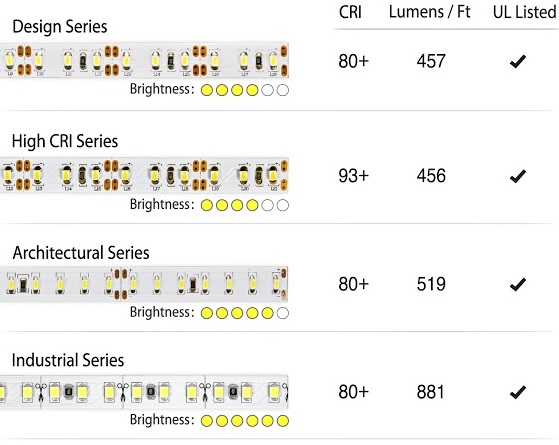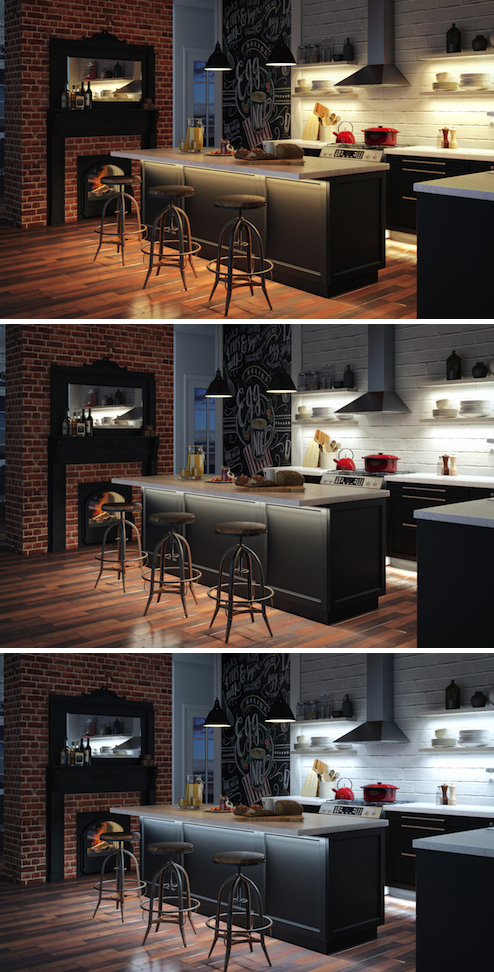90% of customers found this information helpful before choosing their LED strip lights
The use of flexible LED strip lights is rapidly rising in modern lighting design around the world. Architects and lighting designers are implementing LED strip lights into residential, commercial, and industrial projects at an increasing rate. This is due to an increase in efficiency, color options, brightness, and ease of installation. A homeowner can now design like a lighting professional with a complete lighting kit and an hour or two.
There are many options on the market for LED strip lights (also called LED tape lights or LED ribbon lights) and there is no clear-cut standard for how to choose LED strip lights. We have created this guide to educate experts and newcomers alike.
Important notes before getting your project started:
Step 1: Get a clear vision! Because each project is unique, there is no all-in-one solution. Different projects require different types of LED strips.
1. What will you be lighting?
2. Where will it be installed?
3. Do you want to dim your lights or control them with a remote or wall switch?
4. What overall look do you want to achieve?
5. What color do I need?
6. What materials am I lighting?
7. Are there other lights in the area and if so, what color are they?
Ready? Let’s Go!
– Top 4 things you need to know before choosing or comparing LED strip lighting –
1. Compare Lumen, CCT, and CRI (Color Rendering Index)
1.1 Lumen (Brightness)
Lumen is the measurement of brightness as perceived to the human eye. Because of incandescent lighting, we are all accustomed to using watts to measure the brightness of light. Today, we use lumen. Lumen is the most important variable when choosing which LED strip light you need to look at. When comparing lumen output from strip to strip, note that there are different ways of saying the same thing.
The questions you should be asking is “Lumens per what? Per foot, meter, or reel? How long is the reel?”
Different projects require a certain amount of brightness to achieve a desired look. Our advice is to always go brighter than needed and add a dimmer. Running your LEDs below their full power and brightness can also increase lifespan.
Below is a general guide. We are always available to help design your project with you.
Important: Be careful if the company does not state the lumen output. You will have no idea what the brightness will be until you purchase them. Flexfire LEDs has some of the brightest LED strip lights in the world. If quality is important to you, always request the test data sheets from any company to verify their claims of “lumen output”.
Using Lumen as the only comparison can be tricky! Some brands over-power their LEDs to make them brighter. Sadly, this will make them fail faster and burn up. We under power our LED chips to make sure they last longer than rated.
1.2 CCT – Color Temperature
CCT (Correlated Color Temperature) refers to the color temperature of light, measured in degrees Kelvin (K). The temperature rating directly affects what the white light will look like; it ranges from cool white to warm white. For instance, a light source that has a 2000 – 3000 K rating is seen as, what we call, warm white light. Warm white light looks very orange and/or yellow. When increasing the degrees Kelvin, the color will change from yellow to yellowish white to white and then a bluish white (which is the coolest white). Although the varying temperatures have different names, it should not be confused with actual colors such as red, green, or purple. CCT is specific to white light or rather, the color temperature.
“Can I order a 6000k light from amazon and a 6000k light from you and they will look the same?” The answer is quite possibly no. All CCTs are not created equal also. You may notice that some lights that are “cool white” may not look pure white. They may give off a greenish, purplish, or bluish hue to them? This is because the LEDs have been selected from a presorted pile (bin) that is far from true white. It is important to ask the manufacturer of the LED strips how they BIN their LEDs and what their selection process is.
Which color should you choose?
Here is an example of the same kitchen under 3000k, 4200k, and 6200k lights. Notice how lighting changes everything!
1.3 CRI – Color Rendering Index
Can’t tell the difference between the black and navy colored socks in your walk in closet? Could be that your current lighting source has a very low CRI! Color Rendering Index (CRI) is the measurement of how colors look under a light source when compared with sunlight. The index is measured from 0-100, with a perfect 100 indicating that colors under the light source appear the same as they would under natural sunlight.
– This rating is also a measurement in the lighting industry to help discern naturalness, hue discrimination, vividness, preference, color naming accuracy, and color harmony.
– Lighting with a CRI that is measured greater than 80 is considered to be more than acceptable for most applications.
– Lighting with a CRI that is measured greater than 90 is considered “High CRI” lights and mainly used in commercial, art, film, photography, and retail locations. -See our High CRI 93+ Lights


